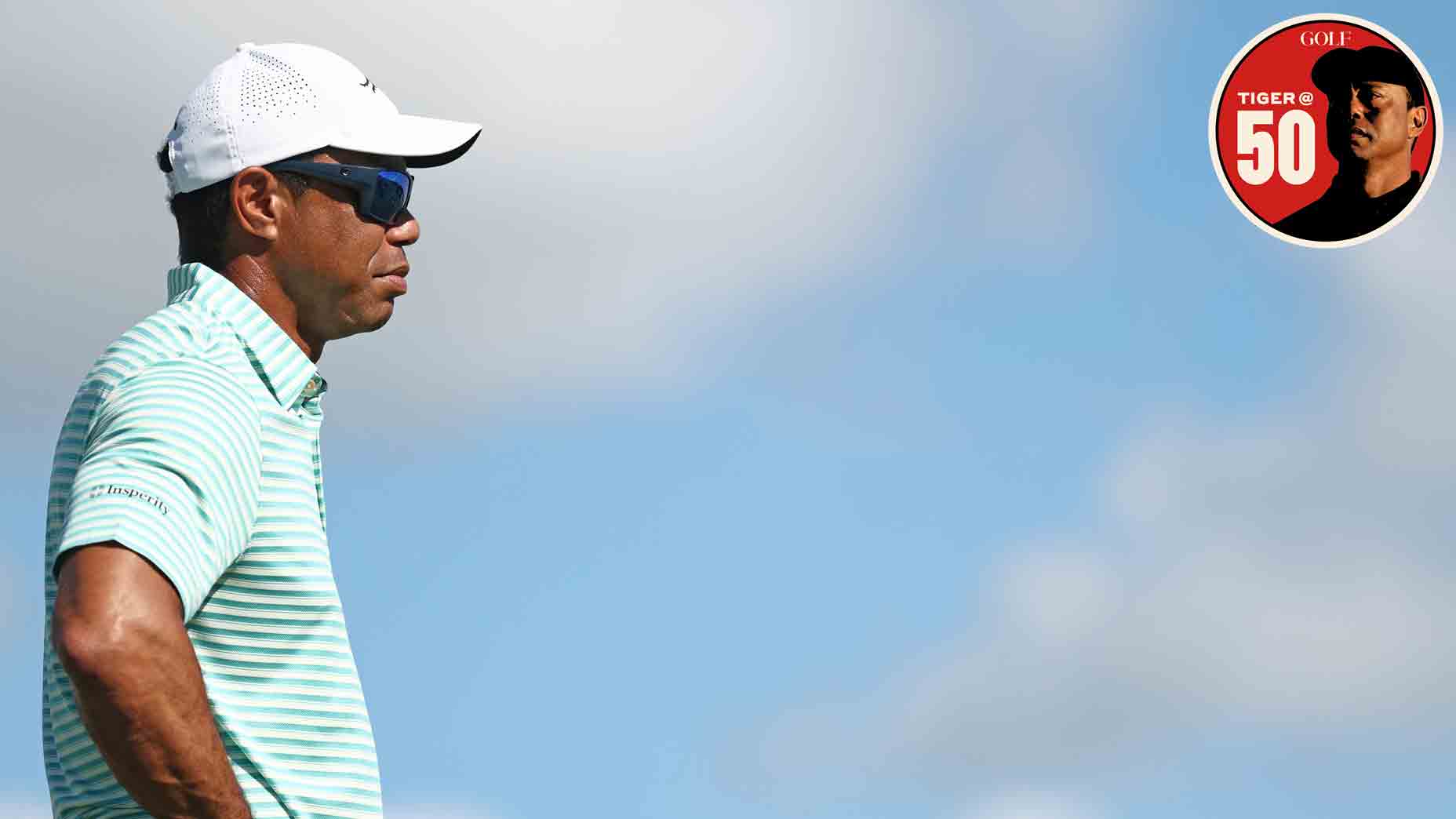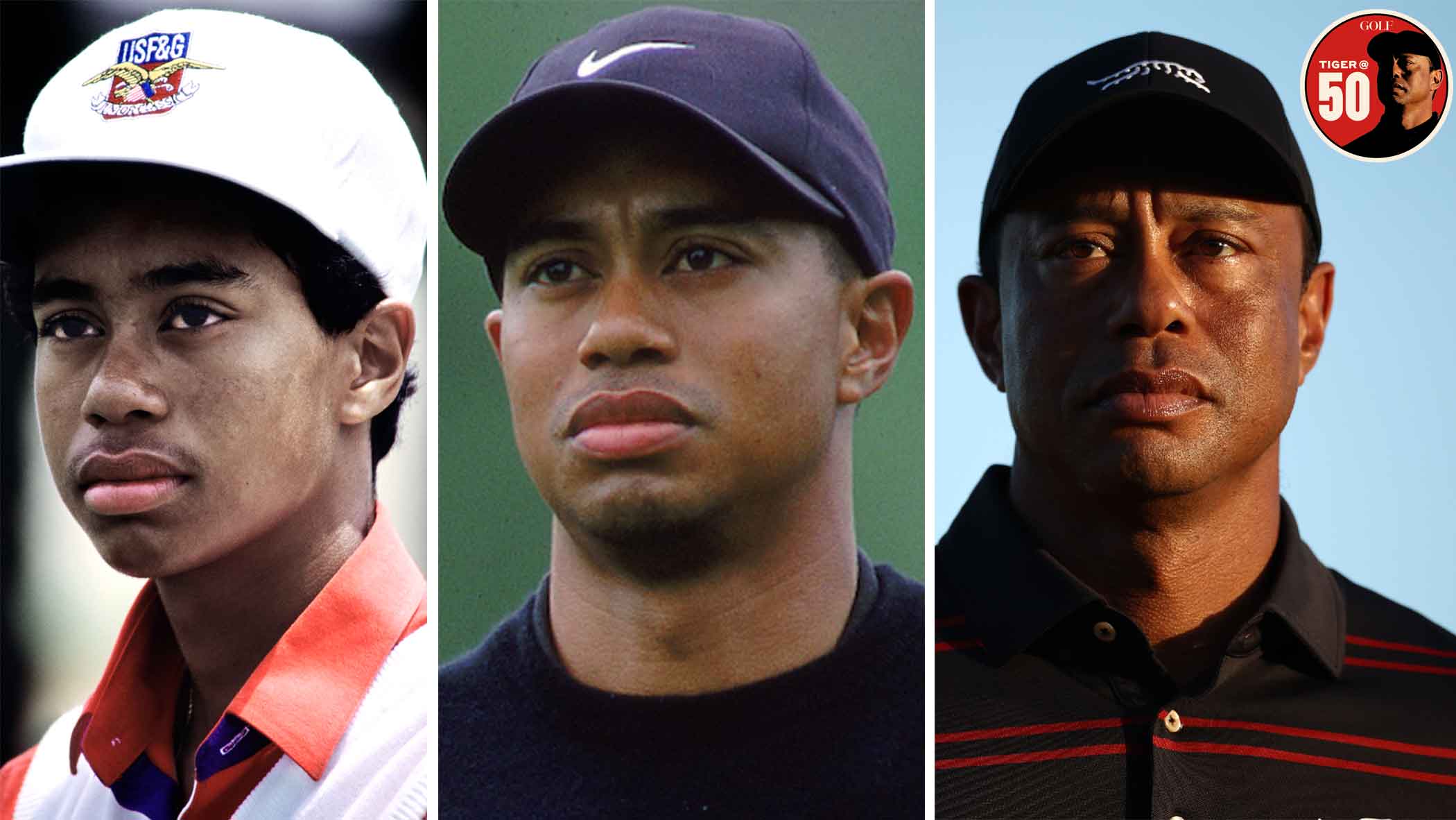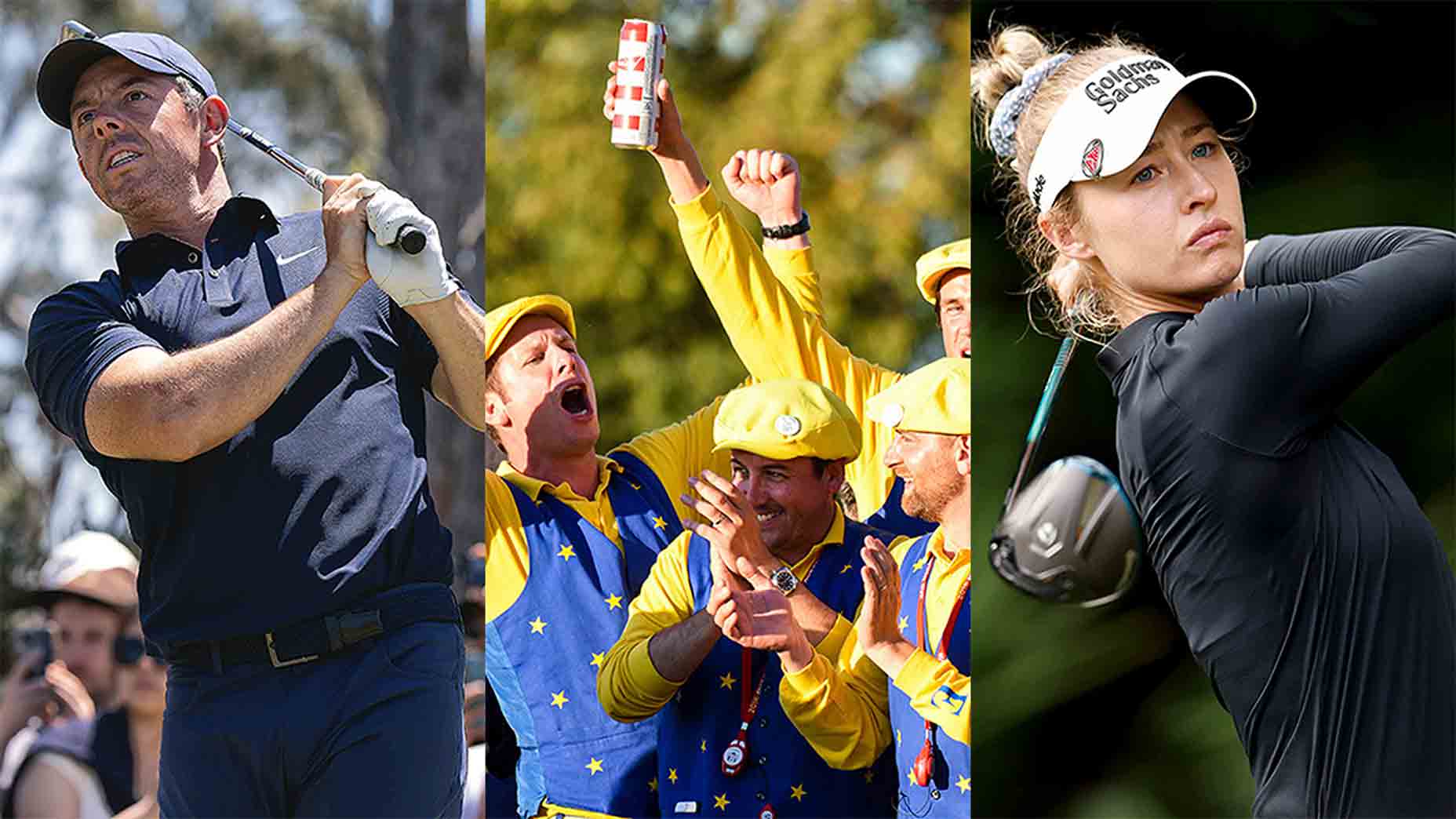To understand the power of Paige Spiranac’s beauty, take a trip with her to Scottsdale Top Golf on a bustling Saturday evening. She is dressed in skin-tight jeans, a snug white top and high heels. As Spiranac, 23, strolls across the third level an unmistakable energy fills the air. Men nudge each other and stare, turning the ogling into a communal event. One dude, about to take a swig of beer, is frozen by the sight of Spiranac, his glass a couple of inches from his lips. Women inspect her from head to toe.
In a culture that worships beauty, Spiranac has hit the genetic lottery: luscious golden hair, sparkling blue eyes, porcelain skin and a figure curvier than 17 Mile Drive. But she has always had a complicated relationship with her appearance, going back to a traumatic childhood beset by physical maladies. From the moment she became an accidental Instagram sensation, she has been objectified on a global scale. Ever since, Spiranac has been fighting to regain control of her sense of self. Her reaction to the first rush of Internet fame, in the summer of 2015, remains instructive: “I’ll never forget the day the craziness began,” says her mother, Annette. “She was getting thousands of new Instagram followers every hour. We were visiting my husband’s relatives and Paige was in her room, laying on the floor in a fetal position, crying. She kept saying, ‘I don’t know why this is happening. I’m so scared.’ You’re talking about a girl who has always been shy and introverted. She simply couldn’t process the attention.”
Spiranac now has 912,000 Instagram followers, a number exceeded among golfers only by Rory McIlroy, Jordan Spieth and Rickie Fowler. From the very beginning these fans (and critics) have monitored the daily routine of a gym rat who likes to wear her form-fitting workout gear to the driving range, a stylish young woman who eschews boxy polos and hits the links in sporty outfits like the ones her tennis-playing aunt favored. If she was dolled-up for a night out she posted those pictures, too; her fans certainly didn’t mind. Through the sheer weight of her audience, a side door to a golf career suddenly swung wide open. By taking advantage of those opportunities Spiranac has become one of the most polarizing figures in the sport. Is she a much-needed agent of change, helping golf reach a younger, more diverse audience while demonstrating the awesome power of social media? Or is she a sideshow exploiting our baser instincts while distracting from the real competition between the ropes? After a year and a half in the withering glare of the spotlight, Spiranac only now is making peace with her place in the game. “All I ever wanted was to be a golfer on the LPGA tour,” she says. “That’s still my dream, but getting there has turned out to be a lot more complicated than I thought.”
*****
When Spiranac was a little girl she had a severe case of asthma that often left her wheezing into an inhaler. A handful of attacks were so severe she was rushed from school to the hospital, unable to breathe. Her parents forbade her from going to the house of any friend with a pet, and sleepovers were out of the question because every night Annette would sneak into her daughter’s room and sit by the bed to make sure she was breathing. Paige also had a rare scalp condition that caused her hair to fall out. She resorted to a short bowl cut, and for much of her youth was mistaken for a boy. Her classmates showed little compassion. “I was this weird kid with a bunch of problems, and they all shunned me,” Spiranac says. “I would sit down at a table and every other kid would stand up and move. At recess one of their favorite games was to throw rocks at me. It was like in a movie except that was my life.”
Gymnastics became Spiranac’s salvation, the place where the judgments were more favorable. Her genes imbued her with grace and power: Annette was a professional ballet dancer, while her husband, Dan, was a free safety at Pitt during the Tony Dorsett years, winning a national championship in 1976. Six days a week Paige brought her laser-focus into the gym, training for up to seven hours at a time. She excelled at the vault and floor routines and still grows wistful remembering the feeling of soaring through air, unburdened. Spiranac jumped from level six to Elites, which in golf terms is like going from high school straight to the LPGA tour. She was good enough to be invited to the Karoli camp, which stamped her as a potential Olympian. Paige and her mom moved to Colorado Springs so she could train at the same gym that produced Kerri Strug and other golden names in the sport.
Convinced their daughter wouldn’t survive the cruelty of middle school, the Spiranacs chose to home-school Paige following sixth grade, and that allowed her to focus even more on gymnastics. But her career ended when she was 12, after she fractured her kneecap on two occasions. Paige mourned for a week or two and then called a meeting with her parents to determine which sport she should throw herself into next. “Being an athlete was so important to my self-identity that even at that age I knew I needed to find another sport quickly,” Paige says. Her aunt Bonnie Gadusek was summoned for a two-week tennis boot camp; she was a former pro who was ranked as high as eighth in the world. But Paige was only lukewarm about tennis, so her father, a mediocre but enthusiastic golfer, suggested she head to the range. “It was love at first swing,” Annette says. “From that day forward Paige was totally committed to playing golf professionally.”
She continued to be home-schooled while competing on the Future Collegians World tour, where twice she was the western region player of the year. Spiranac moved up to the AJGA and in 2009, at age 16, won a tournament in Stockton, Calif. She attracted interest from many top college programs and ultimately accepted a scholarship to Arizona. Attending a large university was a culture shock. “I was so socially awkward,” she says. “I had never had friends my own age. Honestly, I mostly hung out with the old guys at the driving range. I was so innocent too. I had never tasted a drop of alcohol, and all of a sudden I was surrounded by professional partiers.”
Spiranac took the plunge at Arizona, sometimes literally; at one shindig she jumped into a swimming pool from the roof of the house. Naked. “When I would drink I liked to play Truth or Dare,” she says, by way of explanation. But even as she tried to act like a typical college kid she never fit in. Her speech was a bit formal, her manners a little too proper, and she had nerdy hobbies such as collecting comic books. At Arizona the athletes from all sports eat at the same training table, share the weight rooms and use the same tutors. In this cloistered environment Spiranac became the victim of what she calls “mean girl stuff.” She says, “The girls on some of the other teams spread some really, really nasty rumors about me. None of it was true, but it really affected my life. I didn’t have close friends to begin with and the girls I was friendly with just drifted away, because these rumors were so vicious no one wanted to be near me. I’d wake up in the morning hating life and didn’t want to leave my room because I knew I’d have to go be around those girls.”

Asked why she was singled out, Spiranac says, “I guess because I was different. Everyone knew I was home-schooled. Everyone always said I was weird, and they’re kind of right. And I think people can always tell that I’m a weak link. So if you are going to bully someone, I’m an easy target. They know it will affect me because I’m an emotional person and have a soft personality.”
By the end of her sophomore year Spiranac was so miserable she transferred to San Diego State. For the first time in her life she was welcomed by her peers into a loving, nurturing environment. In Leslie Spalding, she also found a coach who believed deeply in her potential.
“I was blown away by Paige’s raw ability,” says Spalding, who played the LPGA tour from 1996 to 2006. “She worked the ball more than any player I had ever been around: low cut, high draw, bend it around a tree. She had all the shots. As far as her power and her ability to shape the ball, the only players I can think of who compare to her are [nine-time LPGA winner] Kelly Robbins and [reigning U.S. Women’s Open champ] Brittany Lang. And then you combine that with an absolutely incredible short game. She has some of the best hands I’ve ever seen, male or female.”
Yet Spiranac’s results did not reflect her skill set. In gymnastics she willed herself to success by working obsessively until she mastered a move. She put in similar hours on the driving range, but getting the ball in the hole in tournaments was a challenge. Under the gun she had a tendency to miss short putts and swing too hard with her driver, leading to a gnarly snap hook. “She was almost too driven to succeed,” says Spalding. “She put enormous pressure on herself to produce a good score, so there were times when she could barely pull the trigger. She would play from a state of panic. The challenge with Paige was always to get her to stop thinking about her score and learn to enjoy the walk, to love hitting the shot and not worry about the result.”
During tournaments Spalding would often walk with Spiranac and tell her jokes, or ask her to recount stories about ex-boyfriends. In practice, she would make Spiranac count from 1 to 10 while hitting shots. When she started doing it by rote, Spalding would pick a random number like 27 while Spiranac was addressing the ball and then have her count from there. The coach was willing to invest so much in Spiranac because she gave just as much back to the program. She was appointed team captain and, says Spalding, “Paige had a profound impact on changing the culture of the team. She was a great leader who got all of the other players to buy in to what we were trying to accomplish. Her work ethic was contagious, and so was her personality. There’s nobody I know who is sweeter, kinder, cares more and follows her heart in everything she does. The whole team rallied around her.”
The Aztecs had never won a conference championship in women’s golf, but in Spiranac’s senior year they were the favorites heading into the Mountain West tournament, thanks in part to her fine play throughout the year, which earned her all-conference honors. On the morning of the final round Spalding says Spiranac was “as tight as a tick,” but she still sent her leader out first. On a tough setup at Mission Hills Country Club, the site of the Dinah Shore (now the ANA Inspiration, the LPGA’s first major of the year), Spiranac fought herself and the course on every swing. She played the front nine in four over par but steadied herself at the turn and came home with an even-par 36, a key contribution to San Diego State’s victory. Afterward, she took another plunge, this one with her teammates into Poppy’s Pond next to the 18th green. “One of the absolute happiest moments of my life,” she says.
As idyllic as Spiranac’s time in San Diego was, the bullies once again cast their long shadow. During her senior year the team made a trick-shot video that lit up the Internet. Soon thereafter her Instagram feed curdled. “People were sending these messages saying, You are such a slut, you’re ugly, you’re a horrible golfer. It was awful, and Paige was really upset and scared,” says Kristina Lynn, her best friend and then roommate. “It went on for a very long time. I started to notice the messages used the same words and had the same grammatical errors. It was like an orchestrated campaign, so I began looking into the people who were sending them. It turned out they were all connected to a person we knew at school who obviously felt threatened by Paige. As soon as we approached this person, the messages stopped. It was ridiculous that people would go out of their way to try to hurt her.”
By July 2015 Spiranac had exhausted her college eligibility and had only two classes left to finish her degree. She still dreamed of playing professionally but knew she had a long way to go. Her family didn’t have the money to stake her travels on the mini-tours—Dan owns and operates a barbershop while Annette works in retail—so Paige was looking to become a caddie or a teaching pro, as either job would allow her to keep working on her game.
The trick-shot video had given the tech-savvy young women at San Diego State their first taste of Internet fame. Unbeknownst to Spiranac, a friend sent a photo of her to Dan Regester, a writer and content manager for TFM Girls, an Instagram account associated with the popular website Total Frat Move. As the name suggests, Total Frat Move traffics in low-brow humor and a seemingly endless supply of young women who send in racy photos of themselves, looking for attention, validation or perhaps a form of career advancement. “I get thousands and thousands of submissions,” Regester says. “Usually it’s just college girls who want to pick up a few hundred followers. Pretty much every girl sends in an ass shot or pictures of their boobs, or both. Honestly, at some point it all starts to look the same. But the picture of Paige was just a photo of her face. It caught me off guard. She had a nice smile, and there was something kind of sweet and wholesome about her. So I checked out her Instagram account, and I could see she was serious about golf. She was dedicated and she had talent, as opposed to all these other girls who just look good. So I decided to spotlight her.”
Regester wrote a cheeky love letter to a woman with whom he had never corresponded. He posted it on Total Frat Move, along with a handful of pictures and golf-centric videos ripped from Spiranac’s Instagram feed. Her life—and the stodgy world of golf—would never be the same.
*****

Within days of Spiranac’s alighting the Internet the momentum began to build. Equipment and apparel companies started sniffing around. Would-be agents circled. Tournament organizers took notice too, and in the summer of 2015 Spiranac received an unexpected direct message on Twitter. “That was the first time I invited a player to a tournament via social media,” says David Spencer, a longtime Golf in Dubai executive. “It was to be the 10th edition of the Ladies Masters, and we were struggling to find effective ways to raise awareness of the tournament. As the promoter we have two keen responsibilities: to our sponsors and to growing the game. I know the latter is a hackneyed expression, but we absolutely believe it to be our responsibility. We detected this social-media explosion around Paige and noted that she was connecting with younger fans and those who might not otherwise be paying attention to golf. It seemed quite obvious to invite her.”
What young, hungry, cash-strapped pro wouldn’t say yes to the chance to play a big-time tournament, especially with the sponsor offering to kick down for the airfare? Was Spiranac supposed to penalize herself because her path had been non-traditional? Should she have said no to a Ladies European tour event simply because she’s attractive? She had been building toward this opportunity for a decade, so Spiranac agreed to make her pro debut in Dubai, in December 2015. The backlash was extreme. Hall of Famer Laura Davies dismissed Spiranac by saying she didn’t know her “from a bar of soap.” The Irish Examiner opined in a headline, “With more selfies than birdies, golf shouldn’t need Paige Spiranac.” In the locker room and on the driving range she experienced a familiar chill. “I felt like I was back in elementary school, when you sit at the lunch table and no one wants to be near you,” she says. “But even though it hurt, I understood. The only pictures the newspapers printed were of me in tight little dresses taking selfies, and I would have probably acted the same way as [the other players] did, you know? Because they’re working so hard and have accomplished so much and they’re not getting the press that they deserve. And I think they were a little put off by what I represented. This has never happened, where someone was building a career through social media. It was new to everyone, even me. And I didn’t know any of the girls so I felt uncomfortable, and I don’t think I did a good enough job to go out of my way to build relationships. But I was so intimidated and nervous because there was so much negativity around me before the tournament even started.”
On the morning of the first round Spiranac puked from all the anxiety. She shot 77–79 and missed the cut, finishing 101st in the 107-player field. Yet her presence made the tournament a smashing success. “Paige created a media frenzy like we had not seen before,” says Spencer. “We had never had TV crews come to the pro-am or press conferences. We were told there were 500 million impressions on social media related to the tournament and that a story about her in The Daily Mail was the most well-read sports story in the world that day and the first time golf had ever outranked football. In terms of television it was the largest viewership ever for an LET event by at least four times. The savvier players on tour, the ones trying to build a career and a brand, recognized that it was a fantastic showcase for them and the tournament.”
Still, Spiranac returned home to Arizona feeling defeated and questioning her future in the sport. That’s when an old friend reached out. Tyler Hall had known Spiranac going back a decade, to when both were practicing at McCormick Ranch in Scottsdale. After years of fruitlessly chasing glory on the mini-tours he had successfully transitioned into teaching. He would become the lifeline Paige needed. “When she got back from Dubai,” says Hall, “she was ready to walk away from the game and all the attention. We had some long talks and worked together a little bit, and her fighter mentality kicked in. The will to win brought her back to the game.”
Spiranac had never had any sustained formal instruction, but she committed to a wholesale rebuilding of her swing. Hall was dazzled by her work ethic and athleticism. “She still has that gymnast body, with tremendous strength in her legs and core,” he says. “She’s very explosive, very flexible, and creates so much speed. I mean, not many women can carry their driver 270 yards. But her swing was pretty wild.”
They have worked to gain more extension on the takeaway while shortening the top of her backswing. On the way down, Spiranac’s club is more on-plane and her arms are out in front of her body, which helps to eliminate the big miss. Throughout 2016 she tried to take the long view, which is antithetical to the blink-and-you-miss-it culture of social media. (Endorsement deals with Callaway Golf and the Descente apparel company have bought her more time financially.) She honed her game on the podunk Cactus tour while turning down sponsor’s exemptions from, she says, “pretty much every tournament on the LET and a handful of LPGA events.” By summer Spiranac felt her swing coming together, so she accepted an invitation from the Scottish Open. In rough weather at Dundonald Links she shot 76–75 to make the cut, ultimately finishing 58th. On the Cactus tour she began to post rounds in the 60s more regularly. At an event in Scottsdale, she faced a do-or-die four-footer on the 54th hole to force a playoff. She gutted it, the exclamation point on a 68. On the first hole of sudden death Spiranac poured in a 25-footer for the victory.
“It was probably more relief than joy,” she says. “It just felt good to get the first one. I was so tired of people saying, ‘Oh, she’s never won anything.’ That’s the go-to put-down, that I’m a wannabe model pretending I’m a golfer. You know what, I was one of the top 25 amateurs in the world. I had a pretty good college career. Now I’ve made a cut at an important tournament like the Scottish Open and gotten my first pro win. I’m not where I want to be, but it’s not a bad start.”
*****

Spiranac’s phone is a portal to a wide range of human emotions. The other day she opened her Instagram feed and scrolled through hundreds of direct message from strangers. They conveyed empathy, thankfulness, jealously, lust, silliness and so much more. “That’s just from yesterday,” she said. On Twitter she had an equal number of direct messages. She responds to a wearying number every day. “If someone takes the time to say something nice, I want to acknowledge them,” she says. “If someone is misrepresenting my playing career, I try to correct them. If they say something mean about me I’ll let them know it hurts my feelings. But I’ve noticed that the best thing for me is to show love back to them and show positivity and by doing that you gain a fan. I don’t do it on a public forum; I message them privately. And I’ve turned so many people around from being a hater to being a fan or even someone I’m friends with. Yes, it takes more time but that’s how you build a loyal fan base and build a community. These people are not just random strangers. A lot of them have been on this journey with me from the very beginning, and we’ve gone through a lot of highs and lows together.”
A year ago, Spiranac got a life-changing direct message on Instagram from a minor-league baseball player named Steven Tinoco. He had been in Scottsdale for a bachelor party pegged to the Phoenix Open. He and his boys were loitering in the lobby of Top Golf when Spiranac walked in with her family. (Older sister Lexie Mitchell was a heptathlete at Stanford and now helps manage Paige’s business affairs.) Tinoco recognized her immediately and asked Spiranac to take a picture with him. The next day he DM’d her the photo and asked her out on a date. This was not an unusual occurrence, but Spiranac says, “His was the nicest DM of that kind I’ve ever gotten. Usually it’s just very inappropriate or, you know, body parts.”
She played hard-to-get for months, but they finally met up when Spiranac was in Carlsbad, Calif., getting her clubs tuned up at Callaway. Tinoco looks like Mark Wahlberg, down to the bulging biceps, but what really impressed Spiranac were his old-fashioned manners. “So he was the first guy who’s ever gotten me flowers and opened up doors for me,” she says. “He took me on a real date, and it was such a refreshing change from Netflix and chill. He’s just a really nice, respectful guy with a good heart. After so many bad relationships I finally met a good one.”
Tinoco, 28, recently retired from baseball and is now working to become a licensed personal trainer. Spiranac is already a pupil, and in addition to the long hours they spend in the gym they also engage in cut-throat matches on the golf course. “What usually happens,” he says, “is I win a few holes and start running my mouth and then she makes a bunch of birdies on the back nine to beat me.” Both seem pleased by the arrangement.
The newfound happiness away from golf is only one of the reasons Spiranac is feeling more comfortable in her skin. From the moment she lit up Total Frat Move she has spent a lot of time ruminating on the question, Why me? The only answer that makes sense to her is to leverage her celebrity for something meaningful. Last month Spiranac returned to the Dubai Ladies Masters and in a teary pre-tournament press conference poured her heart out about all the abuse she had received in the preceding year—from players and reporters and most of all, the tough guys and mean girls hiding behind their keyboards. She mentioned the spike in teenage suicides, many of which have been attributed to cyber bullying. It was a brave, heartfelt confessional, and the ensuing support she received was overwhelming, with hundreds of kids and parents reaching out to her on social media to share their stories and thank her for giving the issue a voice. Thus galvanized, Spiranac recently signed on to be a national spokesperson for the Cybersmile Foundation, a non-profit devoted to addressing cyberbullying. “Taking on this issue that I’m so passionate about has given me a different perspective on my golf,” she says. “I still have very high goals: I want to win tournaments, I want to get to number one in the world. But if I don’t achieve all of that, I can still have a successful career by helping kids and maybe being a positive role model. And if along the way I can help change the perception of golf as something that is a little younger and more athletic and cooler and more fashionable, that’s great too. You don’t have to win tournaments like Lydia Ko to make a contribution to the game.”
As Spiranac continues to reinvent herself, her every move will be cheered and critiqued by the electronic army that obsesses over her. They got to share in the joy of Tinoco popping the question last month in Dubai—they’re planning for a fall 2018 wedding— just as they felt her pain when she struggled through tournament rounds of 77–80. It was a stinging setback for Spiranac, who admits, “I have a love-hate relationship with golf, and sometimes my confidence can be really fragile.”
For now she has turned down countless invitations to play high-profile tournaments as she points toward another full season gaining experience on the Cactus tour. (Last year she played 10 events and finished 10th on the money list.) If all goes well she will roll the dice in the fall at LPGA Q school. In the larger sense, where does Spiranac go from here? A hint may have come at Top Golf, when a member of her party was being grouchy after a shot went awry. Spiranac flashed golf’s most admired smile and offered a piece of advice that doubles nicely as her new mantra: “Relax, it’s supposed to be fun.”





